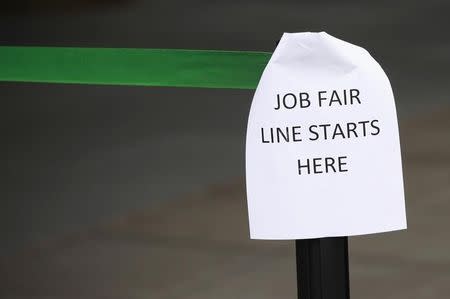More Americans quitting jobs as labor market strengthens
By Lucia Mutikani
WASHINGTON (Reuters) - U.S. job openings surged in December and the number of Americans voluntarily quitting work hit a nine-year high, pointing to labor market strength despite a slowdown in economic growth.
The signs of a robust jobs market could ease concerns about the health of the economy, which were underscored by other reports on Tuesday showing a drop in small business confidence in January to a two-year low and further declines in wholesale inventories.
"If the labor market is tightening, can the economy really be faltering?" said Joel Naroff, chief economist at Naroff Economic Advisors in Holland, Pennsylvania.
Job openings, a measure of labor demand, increased 261,000 to a seasonally adjusted 5.61 million in December, the Labor Department said in its monthly Job Openings and Labor Turnover Survey (JOLTS). It was the second highest reading since the series started in 2001.
The so-called JOLTS report is among the data watched by Federal Reserve officials to get a pulse on both the labor market and inflation.
The increase lifted the jobs openings rate to 3.8 percent from 3.6 percent in November. The hiring rate was unchanged at 3.7 percent, indicating that employers were having trouble finding qualified workers for vacant positions.
A total of 3.1 million Americans quit their jobs in December, the highest number since December 2006. That pushed the quits rate, which the Fed looks at as a measure of confidence in the jobs market, to 2.1 percent - the highest level since April 2008.
The dollar pared losses against the yen after the data, while U.S. stocks briefly reversed losses. Prices of long-dated U.S. Treasuries were trading higher.
The report came ahead of Fed Chair Janet Yellen's testimony to Congress on Wednesday. A raft of weak economic reports, plummeting oil prices and a stock market sell-off have raised doubts as to whether the U.S. central bank will hike interest rates this year.
The Fed raised its overnight benchmark interest rate in December, its first hike in nearly a decade. The economy, however, has been undermined by a strong dollar, sluggish global demand and an effort by businesses to sell off inventory.
Ongoing capital spending cuts by energy firms also are weighing on growth.
SLACK BEING REDUCED
"Skeptics may argue that these (JOLTS) numbers are backward looking, and that spillovers from tighter financial conditions or the energy slump will curb labor market dynamics in the months to come," said Harm Bandholz, chief U.S. economist at UniCredit Research in New York.
"This is certainly a risk and one important reason why the Fed is currently sitting back and waiting. But why should this happen now when it hasn't over the past several months? After all, oil prices started to fall in mid-2014, and most of the adjustment occurred in the first half of 2015."
The number of unemployed job seekers per open job, a measure of labor market slack, fell to 1.4 in December, the lowest level since March 2007 and down from 1.5 in November.
"Diminishing labor market slack has led to a modest increase in wage growth, evident across several measures of worker compensation," said Jesse Hurwitz, an economist at Barclays in New York. "We expect that wage growth will continue to move up gradually, helping core inflation return toward target once the headwinds from lower import prices subside."
While a separate report from the National Federation of Independent Business showed its Small Business Optimism Index fell 1.3 points to a two-year low of 93.9 in January, businesses continued to report tightening labor market conditions.
Small businesses reported a shortage of qualified workers to fill job openings, prompting some to start raising wages to attract and retain them. The share of small businesses raising compensation increased to its highest level since 2007.
"The combination of more job openings and more people quitting could result in pay increases, and we have seen a few other signs that wages have increased as the labor market has tightened," said Daniel Silver, an economist at JPMorgan in New York.
Wage growth, which has been frustratingly slow, picked up significantly in January. Still, growth in average hourly earnings is yet to break above 2.5 percent on a year-over-year basis. Economists say wages need to grow between 3 percent and 3.5 percent to lift inflation near the Fed's 2 percent target.
In a third report on Tuesday, the Commerce Department said wholesale inventories dipped 0.1 percent in December after dropping 0.4 percent in November.
The weak inventory data added to soft December construction spending and factory orders reports in suggesting that fourth-quarter GDP growth could be revised down to an annual rate of about 0.4 percent from the 0.7 percent pace reported last month.
The government will publish its second GDP growth estimate later this month.
(Reporting by Lucia Mutikani; Editing by Paul Simao)



